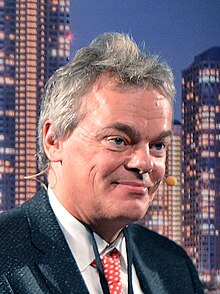Edvard Moser
Norwegian psychologist and neuroscientist
Edvard Ingjald Moser (pronounced [ɛdvɑɖ moːsɛr]; born 27 April 1962) is a Norwegian psychologist and neuroscientist. He works at the Kavli Institute for Systems Neuroscience, at the Norwegian University of Science and Technology (NTNU) in Trondheim.[1] In 2005, he and May-Britt Moser discovered grid cells.[2]
Edvard Moser | |
|---|---|
 Edvard Moser in 2015 | |
| Born | Edvard Ingjald Moser 27 April 1962 |
| Nationality | Norwegian |
| Alma mater | University of Oslo |
| Known for | Grid cells, place cells, border cells, neurons |
| Spouse | May-Britt Moser (1985–2016) |
| Children | 2 |
| Awards | Louis-Jeantet Prize for Medicine (2011) Foreign Associate of the National Academy of Sciences (2014) Nobel Prize in Physiology or Medicine (2014) |
| Scientific career | |
| Fields | Neuroscience |
| Institutions | Norwegian University of Science and Technology University of Edinburgh |
He won the Nobel Prize in Physiology or Medicine in 2014 with May-Britt Moser and John O'Keefe for their work identifying the brain's positioning system.
He was elected a member of the Academia Europaea in 2011.[3]
References
change- ↑ "Edvard Ingjald Moser". www.ntnu.no (in Norwegian Bokmål). Retrieved 4 September 2018.
- ↑ Hafting T, Fyhn M, Molden S, Moser MB, Moser EI (2005). "Microstructure of a spatial map in the entorhinal cortex". Nature. 436 (7052): 801–6. Bibcode:2005Natur.436..801H. doi:10.1038/nature03721. PMID 15965463. S2CID 4405184.
{{cite journal}}: CS1 maint: multiple names: authors list (link) - ↑ "Edvard Moser". Academia Europaea. Archived from the original on 28 March 2019.